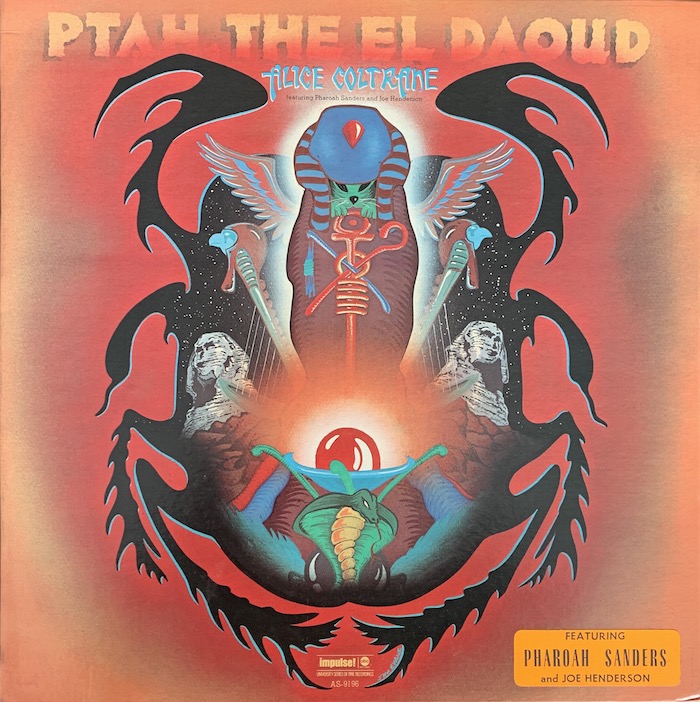
One of the artists mentioned in the previous post was multi-instrumentalist Alice Coltrane who plays both piano and harp on Joe Henderson’s elemental offering ‘Fire’. This wasn’t their first musical collaboration as they had already worked together on her own cosmic masterpiece, Ptah, The El Daoud, recorded at the Coltrane’s home studio in 1970 and released on Impulse! records.
This was Alice Coltrane’s third solo album and comprised of four original compositions on which she plays piano and harp. Her musical voice both reveals her blues and gospel roots and the influences of Eastern spirituality and music. She’s very much centre staged but ably supported by Joe Henderson and Pharoah Sanders doubling up on tenor sax and alto flute, and master bassist Ron Carter. Recorded on the left and right channels respectively, Henderson provides what Coltrane refers to as ‘the intellectual side’ whilst Sanders takes an approach that is ‘more abstract, more transcendental’.
The album’s title references ‘Ptah‘, an Egyptian God who was the creator who existed before all other things and willed the world into existence. ‘The El Daoud‘ means ‘the beloved’. During their brief time together, Alice and her husband John Coltrane travelled the world, developing a particular interest in various Eastern religions and philosophies, the influence of which run through this album from the title and cover art to the music itself.
However, in contrast to other pioneering musicians of the time, such as Sun Ra and Herbie Hancock, for whom their interest in the cosmic and spiritual was more outwardly exploratory, for the Coltranes, their interest focussed in on the personal inner experience, a point well made by critic Hua Hsu. As Ashley Kahn observes in his book A Love Supreme, ‘John was very aware of the Vedantic, the Hindi way of reincarnation and other modes of worship and divinity, of the divine being within instead of up on a cloud.’ For Alice and her husband, music and spirituality went hand in hand and connection with God and the divine was to be found within.
Towards the end of his life, John Coltrane ordered a harp to help him rethink his approach to harmony and texture. Sadly, he died before it arrived. Following her husband’s death, a grieving Alice, plagued by hallucinations and insomnia, took up the instrument and taught herself to play. For her, it represented a sort of spiritual link to her husband, and its celestial sound would become a defining feature of her late 60s and 70s work. At the time, critics dismissed her music as unoriginal and derivative of her husband’s. An appraisal of her work now shows how this reflected the sexist attitudes of the day towards female musicians, especially to those playing the harp, an instrument uncommon in jazz.
On the track ‘Blue Nile’, Sanders and Henderson replace their horns for alto flutes, and Coltrane moves from piano to harp. Like a river, the track gently flows with shimmering harp runs and peaceful flutes, underpinned by a deep and resonant bass line. As Leonard Feather remarks in the album’s liner notes, ‘the spiritualism and mysticism, the legacy of John Coltrane’s guidance that informed her earlier works seem to have been communicated here to Sanders and Henderson. The oneness among the musicians is never more apparent than in Blue Nile.’
Later that year, Alice Coltrane would go on to record what is arguably her crowing masterpiece, Journey In Satchidananda, which continued to explore this cosmic musical direction. Initially only residing in the collections of knowledgeable crate-diggers and collectors, Ptah, The El Daoud is now rightly recognised as a pivotal work in the canon of spiritual jazz and the reverberations of Coltrane’s harp are still being felt today.
Finally, I leave you with a fantastic video of a live solo performance on harp from Coltrane herself. Hear more of her amazing playing in our ‘Harpin’ On’ playlist or explore the freer and deeper side of jazz in our ‘Spiritual Sounds’ playlist.
If you enjoyed this post and want to stay updated, make sure to subscribe to our Spotify playlist and follow us on Instagram and Twitter!
